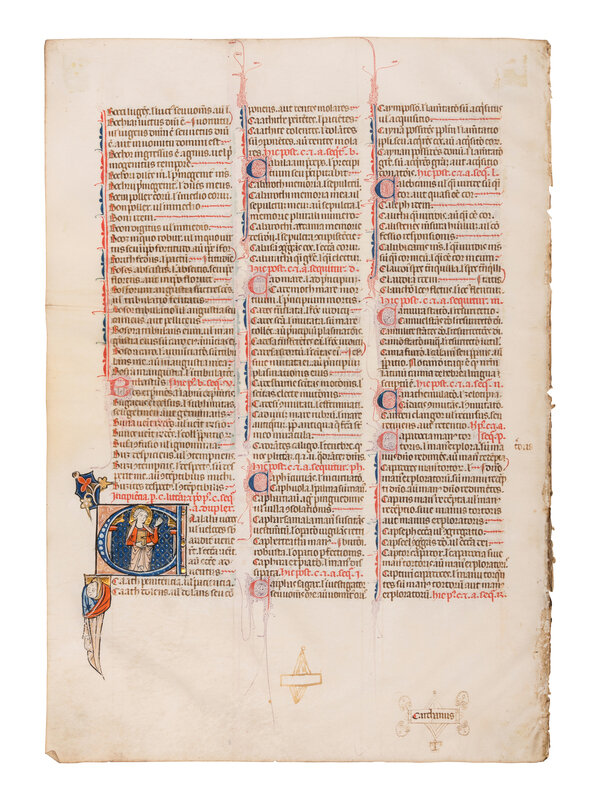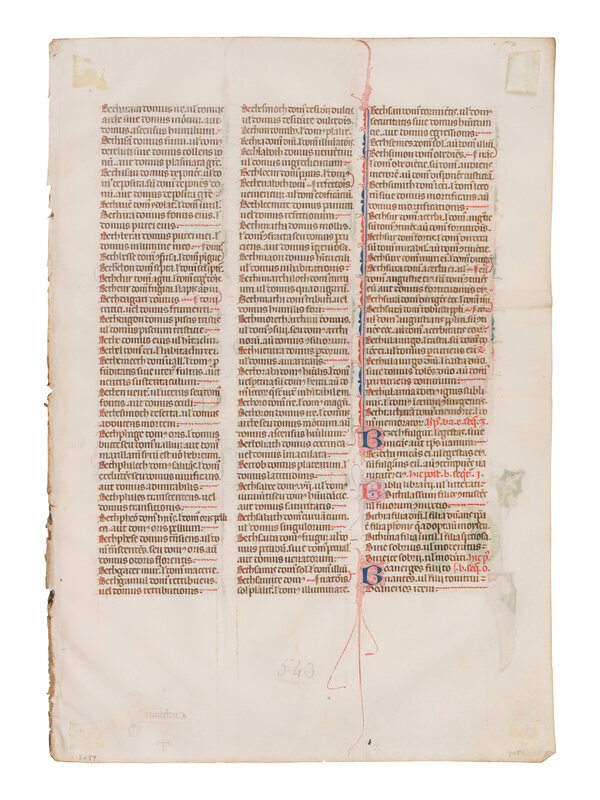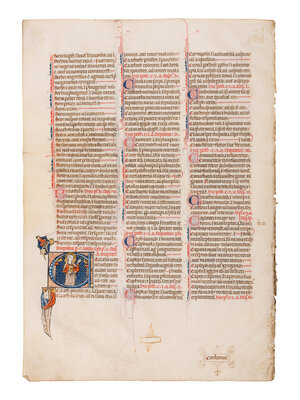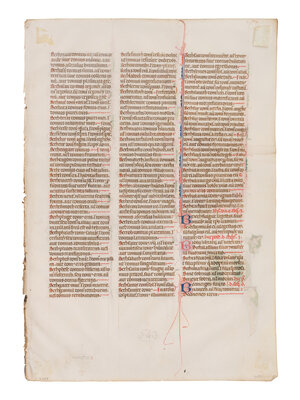Lot 18
UNKNOWN SOUTH FRENCH ILLUMINATOR
A leaf from the Mailhac-Faber Bible, with a historiated initial ‘C’ of a Young Saint, in Latin, illuminated manuscript on parchment [France, Southern France, late thirteenth or early fourteenth century]
A leaf from the Mailhac-Faber Bible, with a historiated initial ‘C’ of a Young Saint, in Latin, illuminated manuscript on parchment [France, Southern France, late thirteenth or early fourteenth century]
Sale 2033 - Western Manuscripts and Miniatures
Jun 27, 2024
10:00AM CT
Live / Chicago
Own a similar item?
Estimate
$5,000 -
6,000
Price Realized
$6,350
Sold prices are inclusive of Buyer’s Premium
Lot Description
UNKNOWN SOUTH FRENCH ILLUMINATOR
A leaf from the Mailhac-Faber Bible, with a historiated initial ‘C’ of a Young Saint, in Latin, illuminated manuscript on parchment [France, Southern France, late thirteenth or early fourteenth century]
A leaf from the Mailhac-Faber Bible, with a historiated initial ‘C’ of a Young Saint, in Latin, illuminated manuscript on parchment [France, Southern France, late thirteenth or early fourteenth century]
Once owned by Chester Beatty, the Mailhac-Faber Bible was a grand and majestic example of a late thirteenth-century Bible.
330 x 230 mm. Single leaf, paginated ‘543’ in a nineteenth- or twentieth-century hand in pencil in the lower margin of the recto, ruled in plummet for three columns of 47 lines (written space: 225 x 175 mm), written below top line in brown ink in a formal gothic bookhand, with a catchword on the lower right corner of the verso, decorated in an elaborate frame, capitals touched with red, rubrics in red, penwork bar border of alternately red and blue running the height of each column and extending into the upper and lower margins, nine two-line initials alternately in red and blue on contrasting penwork, ONE SEVEN-LINE HISTORIATED INITIAL in blue on light brown and blue checkered ground, with white tracery and burnished gold disks, continued into the margin in blue and burnished gold extensions, in-filled with ivy leaves and a hooded figure clad in blue tunic, light brown cloak, and red shawl (browning on the sewing edge, tape stain at upper right corner, a later hand imitated the design of the catchword frame in brown ink next to the original, else in very good condition).
This leaf comes from the second volume of a very large two-volumes Bible written in Southern France that belonged to Alfred Chester Beatty (his W.173, see below). It contains the Interpretations of Hebrew names from “Betharam” as far as the end of names beginning “Cap-” followed by the catchword “Carchanus.” Most of the names are found in St. Jerome’s treatise on the Interpretation of Hebrew Names. In the parent manuscript, as described in the auction catalogue of 1955, this section was said to constitute an appendix, occupying the twenty-four last leaves of the manuscript. In keeping with the other sister leaves from the same section, the historiated initial C for “Caalaha” serves to indicate the letter followed afterwards and represents a young saint standing in the middle of two columns, holding a book in one hand and raising the other hand.
As suggested by its sixteenth-century provenance, this manuscript was most likely written and illuminated in Southern France. This is supported by the parchment, script, and rather brown ink. A common feature that recurs among the identified historiated initials of this manuscript is the inclusion of two columns on each side of the figures, as is the case here, which in some other initials support a cusped arch. Further peculiarities that demonstrate the original approach of the artist include the single gold disk isolated on the ground of the initial.
Provenance
(1) Sam Fogg, London, acquired in November 1996 by:
(2) Robert McCarthy, London, MS BM 1067.
Parent manuscript
1. This leaf comes from the second volume of a two-volume Bible that would have been written and illuminated in Southern France in the late-thirteenth or early-fourteenth century. In 1969, the volume consisted of 286 leaves, with one large Tree of Jesse at the start of Matthew and 107 illuminated initials, of which 76 were historiated.
2. It remained in the area in the sixteenth century, when two monks, “Frere Jehan Mailhac,” north-west of Narbonne, and “Frater Renatus Faber Bourdelois,” of Bordeaux, added their names at the beginning and end.
3. It was owned in Spain by either Juan de Iriate (1702-1771), Carlos Antonio de Laserna de Santander (1752-1813), or the Marquess of Astorga, all of whom sold manuscripts to:
4. Thomas Thorpe (1791-1851) purchased it from one of these owners; bought from him by:
5. Sir Thomas Phillipps (1792-1872), his MS 2506, bound for him in 1849; by descent to his grandson:
6. Thomas Fitzroy Fenwick (1856-1938); purchased from him by:
7. Alfred Chester Beatty (1875-1968), his W. MS IX, re-numbered W. 173, exhibited in 1955 in Dublin; given to:
8. Edith Chester Beatty (1886-1952) and returned to Alfred’s ownership after her death; sold at his posthumous sale:
9. Sotheby’s, London, 24 June 1969, lot 57 acquired by:
10. Alan G. Thomas (1911-1992), his Catalogue 23, 1969, no 5, and sold to:
11. Philip C. Duschnes (1897-1970), who dismantled it and offered leaves as early as 1975.
Sister leaves
Sister leaves with and without historiated initials are to be found in several public collections, including Dublin, Chester Beatty Library (W.173.1; W.173.2; W.173.3); Eagle Rock, CA, Occidental College; Dunedin, New Zeeland (Reed fragment 41); and Notre-Dame, IN, Snite Museum of Art (Acc. 1975.43; Acc. 1975.57). A further four are in the McCarthy collection published together with the present one in his catalogue as no. 61 (see below). For a recent list of thirty-one sister leaves with historiated initials, see Kidd 2021, no. 61, p. 203-205.
Two sister leaves are also included in this sale as lots 23 and 24.
LITERATURE
On the present leaves as well as their parent manuscript and sister leaves, published: Thomas Phillipps, Catalogus Librorum Manuscriptorum in Bibliotheca D. Thomæ Philipps, Bart., A.D. 1837, reprinted by A.N.L. Munby, London, 2001, no. 2506; R.O. Dougan, A Loan Collection of Western Illuminated Manuscripts from the Library of Sir Chester Beatty, Dublin, 1955, no. 9; Sotheby’s, London, 24 June 1969, lot 57; Alan G. Thomas, Catalogue 23, Fine Books, London, 1969, no.5; Peter Kidd, The McCarthy Collection. Vol. III. French Miniatures, London, 2021, no. 61, pp. 203-211 (with further literature). Freeman’s | Hindman thank Senior Consultant Sandra Hindman and Elliott Adam for their assistance in preparing this sale.
The Collection of Robert McCarthy
Condition Report
Contact Information



